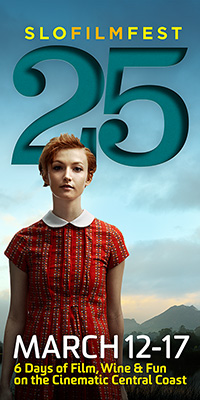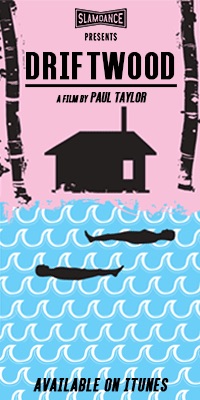Cati Gonzalez has made a film that only an emotionally honest alchemist such as herself could concoct. EKAJ is a stunning work, one which will at once be unfairly dismissed for its disregard for production value and overvalued for “grittiness” as if anybody with a camera and some homeless drug addicts could achieve so great a work of art as this is. Delving deep into the triumphs and torments of a gay teenage street hustler, the authenticity hits so hard, one wonders how Ms. Gonzalez could possibly have targeted such a lofty goal – until now. A revealing chat with the freshman director opens a window in to the madness and method behind this jazz-improvisation of a film. What emerges is a picture of a different type of professionalism, one not rooted in mechanical skill, but in courageous exploration of the most difficult places within the human soul. Aspiring filmmakers are welcome to find inspiration in this chat, but would be well advised not to expect a roadmap to aesthetic breakthroughs. There’s no Film School 101 here, just spiritual insight, unwavering commitment and an unflinching dive into seeking new modes of expression.
The following are excerpts from a much longer interview. These are the 10 Burning Questions for EKAJ and Cati Gonzales.

EKAJ
1. Miguel Cima: Congratulations on making a film which defies convention and dares to construct its own visual language. What you and your cast and crew have achieved is something incredible to behold. What drove your aesthetic choices in constructing the film?
Cati Gonzalez: Well, I guess it’s because I was a photographer for so many years. I’m very visual. So the first thing I fell in love with was the first two characters of the first ten minutes [of the film]. I met the one who [played] the “bad guy” with EKAJ, and then EKAJ. I had already written my Midnight Cowboy sort of movie, and I decided to switch it to these two gay characters. The [actor playing the] first character, Geo, who plays the pimp, was taking hormones to turn into a woman during the shooting. And his roughness, and his personality and his edginess totally [fell apart]. So, I was shooting the film – and it was terrible! It was terrible. I was like, “What’s wrong with him?” And he wouldn’t tell us that he was on hormones. Very dramatic! Finally, I said, I can’t keep shooting with him. So in the middle of shooting with a small budget, I had to take him out, and find another character. That’s when I found Mecca [played by actor Badd Idea]. Editing was tough to try to make the story work with the first guy and the second guy. Besides the fact that they were irresponsible, they wouldn’t show up. More than irresponsible, it’s that they had so many problems.
Making a movie was such a dream for them – but so unrealistic. One day they would be convinced, the next they would be depressed about their own problems. And they became part of a family. If somebody had been filming me filming then – it would have been an [Oscar-winning] movie! It was funnier behind the scenes and more dramatic and sadder than it was in front of the camera. And it was my first film. I was used to doing photography and working with these types of characters all the time. There is a flaw I had. I’m used to taking pictures. So they’re short – cut! I would cut too fast in many instances. The other part was that I had to put scenes together where there was drama, where one [actor] was too high, and I had to get him to say the lines a hundred times. So it was a combination of the two. [Regarding my style], the transfer from photography to film – I would never [shoot with] a camera straight, without moving. Because life isn’t like that. When you walk, everything shakes, [it’s] how you see things. I’m always going to be more raw than somebody else with the camera.
2. MC: The centerpiece to the film is the relationship between EKAJ and Mecca. What could’ve been a common narrative contrivance was buoyed by the amazing chemistry between [lead actors] Jake Mestre and Badd Idea. Tell me about how that chemistry happened.
CG: I guess I have an instinct. I’ve lived so much life. I’ve travelled the world with photography, to very wild, wild settings. When it comes to a great face or a great character, I have a great sense. I’m very advanced [in that way]. If I have to cast and put two people together, and they’re going to synch – that is an instinct that I think I have over other people. I just knew it. As a matter of fact, the first day of shooting, I knew the chemistry was going to go high, but it went even higher. They went out partying that night and kind of ruined it for me the next day! But I used it. Raw people, I know how to put together. It’s probably the best thing I know how to do. Sometimes, they would start talking on their own in the middle of a scene – and I did [use some of those moments in the final film]. These are people I [already like]. Even though they’re sometimes unbearable and I just want them to go! It’s like when you have a sister or brother you can’t stand, but you love them.

Jake Mestre plays the title role, in EKAJ.
3. MC: You’re not the first movie director deeply rooted in photography. Stanley Kubrick is one of the most famous examples of that career path. However, where Kubrick used a sort of advertising approach to “sell” his scenes, you lean more into expressionistic influences to make us feel things on many more levels than Kubrick could. What was your artistic philosophy in achieving this?
CG: I never understood what it is about me that lets me capture that “raw moment” as a photographer (that’s what they tell me). Just take it like – “OK!” [laughs]. I just look at the picture, it’s not like I love my work. I just know that’s what I do. I look for “the real” – it’s like “Beauty in the raw.” And try to get the moment “real.” Even if I have to fool the people [I’m photographing]. I can’t stand set-up. I can’t stand rehearsal. I can’t stand when it’s fake. If [I hear a line] and it sounds fake, I break the moment, and I’ll even act it out for [the actors]. That would make them start laughing, break the moment – and then they’d do it right. I only like “real.” But I like Stanley Kubrick. I admire people who do completely different work from what I’m doing. Every photographer has their style. I just like raw.
4. MC: Your editing scheme also feels like it’s drawn from the same well as abstract expressionism or maybe William S. Burroughs’ “collage” style of writing. What made you choose this approach and what did you want it to achieve?
CG: I never had formal training – I didn’t even finish high school. But then I’ve read very intellectual books. I find that everyone who has been trained in photography or in filmmaking produces the same style, the same color. I learned to be secure in what I produce even though it didn’t fit the conventions. I’m secure enough in my editing and shooting from [my photography work]. I knew what I wanted. In this movie, I had to put together things to make the story become the story. It wasn’t like, I filmed this, shot one, shot two, shot three. A lot of street [shots] in between… That’s the way I shoot – which I’ve been doing for more than 20 years – it’s like I don’ think about it. I just do it.

EKAJ
5. MC: I really like the use of music in your film. Too often, the use of music cues is used to “instruct the audience” what to feel. You chose to almost mock that idea, using intrusive snippets to disorient and reorient the viewer at the same time. How did your soundtrack use augment your storytelling style?
CG: Well, I’ve never had to put music to my pictures. But I love music, it’s a huge love of mine. I guess it was a challenge. I wanted [the scenes in the film to be] more quiet. I [wanted to use] other music – but I couldn’t afford it. So I dug until I found [this other music]. I watched the film recently at a festival in Malaga, and I was like – “Do I have too much music? Do I have too little music?” It’s almost like, that’s the surreal part of my film.
6. MC: EKAJ is a deeply emotional work, which quite frankly, left me traumatized for days, while also filling me with a sense of celebration for the human soul. You have mentioned there was a lot of crying on set. How did the emotions on the set play on the filmmakers involved?

Jake Mestre being filmed as Ekaj.
CG: Jake [Mestre] was going through similar problems [in real life] – even closer [to his character] than I thought. They were both going through similar problems. I picked them because I knew [that]. So, it was very rough. Sometimes [we shot] scenes I didn’t want to be too rough on him. Maybe I was a little kind! There were times that I stopped myself because I thought it would hurt them or something. When I picked Mecca, I had already written about a guy with AIDS. It was rough for me because [actor Badd Idea] has AIDS. Every scene, I would pass it by him before [filming]. I’d ask, “Are you OK saying that?” Even though he was outspoken about [his disease]. So, it was rough. Jake grew up while we were making the movie. If I could do it again, I know [now] how I would do it [differently]. But I like challenges. I’m very extreme [when it comes to] challenges.
7. MC: The backdrop of EKAJ is this murky, urban underworld filled with many of the customary tropes: drug abuse, violence, sexual misadventures, crime. And yet, the sense of joy and the loss characters go through are as universal in any setting. Do you think you could have pulled off the same kind of movie in a reverse image of this world? Maybe a bunch of rich kids? Or country club people or something like that?
CG: Oh yes! Because I’ve lived that life. I’ll probably be doing movies about drugs and abuse for the rest of my life because I know [all those worlds]. My daughter went to Brown. She went to boarding school. My kids are two preps! I brought them to Brooklyn. They know what’s going on! Because I [came from poverty] and was married [into] high society, I know both words and I like to show their controversies. But at the end of the day, I love to show the love. The love of dysfunctional people. That’s what the movie was about.
8. MC: So many of the individual shots feel improvised, and yet it’s hard to believe there wasn’t an enormous amount of planning ahead of time, being that the cohesive structure of the film is so tight. To me, it feels like a bunch of old jazz pros who are so professional, they can let loose in a freestyle jam and never miss a beat. Which is weird because this is your first film, and most of the actors were also freshmen. Can you tell me about the ratio of planning to improve?
CG: This is how it went. I’d give [the actors] the script – of course they didn’t memorize it. They read it, they approved it – I think they changed about two words at the beginning. I’d say, “Learn the lines, and the next day, say them how you would say them.” And then they would go to another planet. So, I would have to [feed them] the lines. Behind the scenes, it was hilarious. I would go, “La la la – say that!” and they would say it! Really! Boom! Shot! Cut! Done! If in that moment, they wanted to do it, they’d get it right, right away. If they [were having personal problems], it was harder to get them to focus. I would cook for them, give them some food. I shoot very relaxed – I never made it like a [professional] set. Except [when it was time to be quiet]. I’m very informal. I want to get you when you’re not thinking. When you’re very calm. I want to get you when you’re very comfortable. And then – just give you a line you would say anywhere. Which was not as easy as I thought!
9. MC: How did you come up with the characters’ names?
CG: The actors chose the names. [Jake] was sixteen at the time. And shy with me. I said, “What do you want your character to be called?” He said, “EKAJ, it’s Jake in reverse.” And I thought – perfect. Only a kid who’s sixteen years old and doesn’t know what he wants in life could come up with that name! [I did that] for the movie to be more real.

Jake Mestre in EKAJ
10. MC: I need to see more work from you and your cast. Will we be seeing more from you folks in the future?
CG: [Jake] wants to act, but he’s not sure. I think it’s good that he gets his life together. I don’t want to deviate him from that. I’m writing [a screenplay]. We’re fundraising soon, [talking to distributors]. I would love to do a remake of Gloria [by director John Cassavetes]. If I wanted to do Superwoman, – that’s Gloria. A woman who is sick and tired of the bullshit of man.

Ekaj director, Cati Gonzalez
Ekaj recently screened at the Women Texas Film Festival, The film will next screen at Festival Santurzine in Santurce, Pais Vasco, Spain.








READER COMMENTS